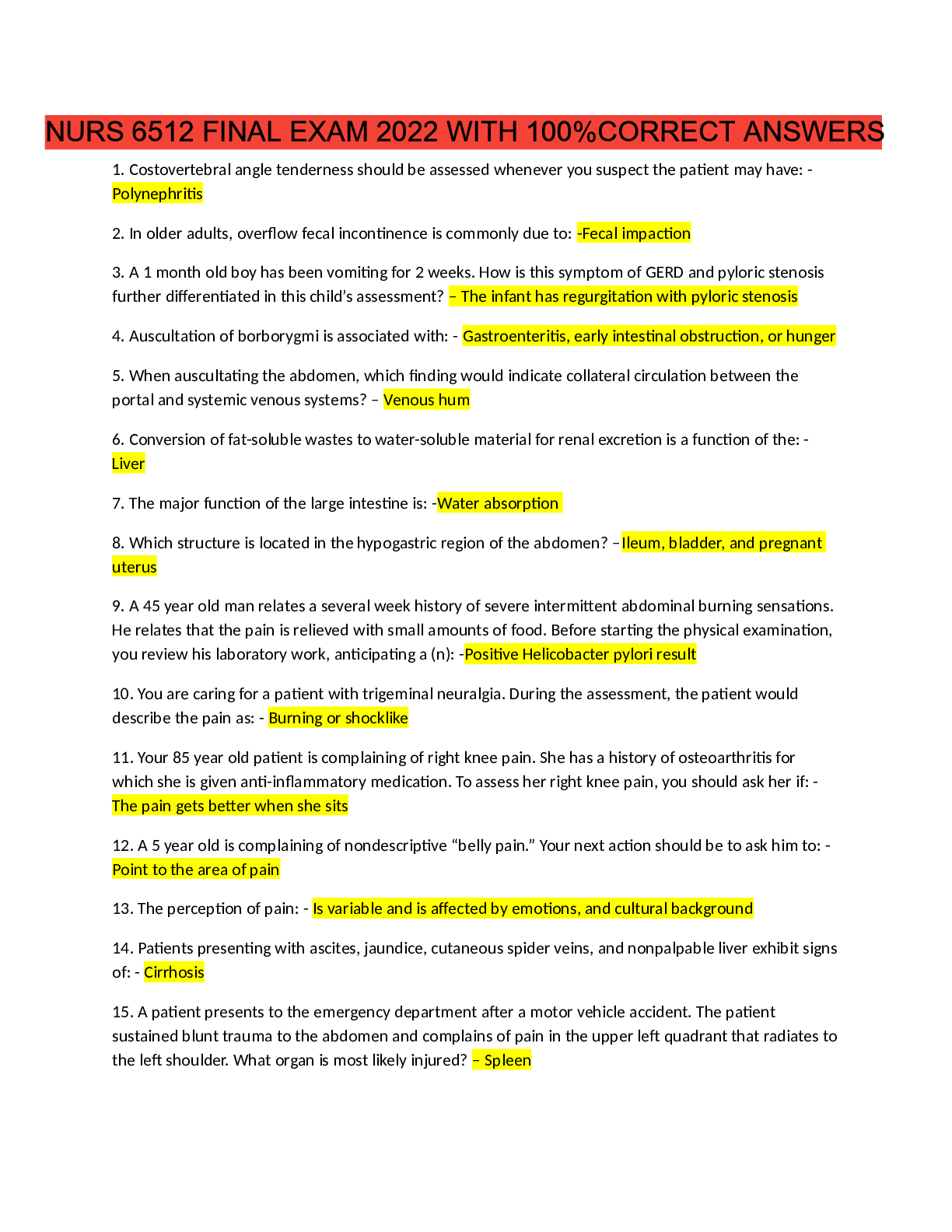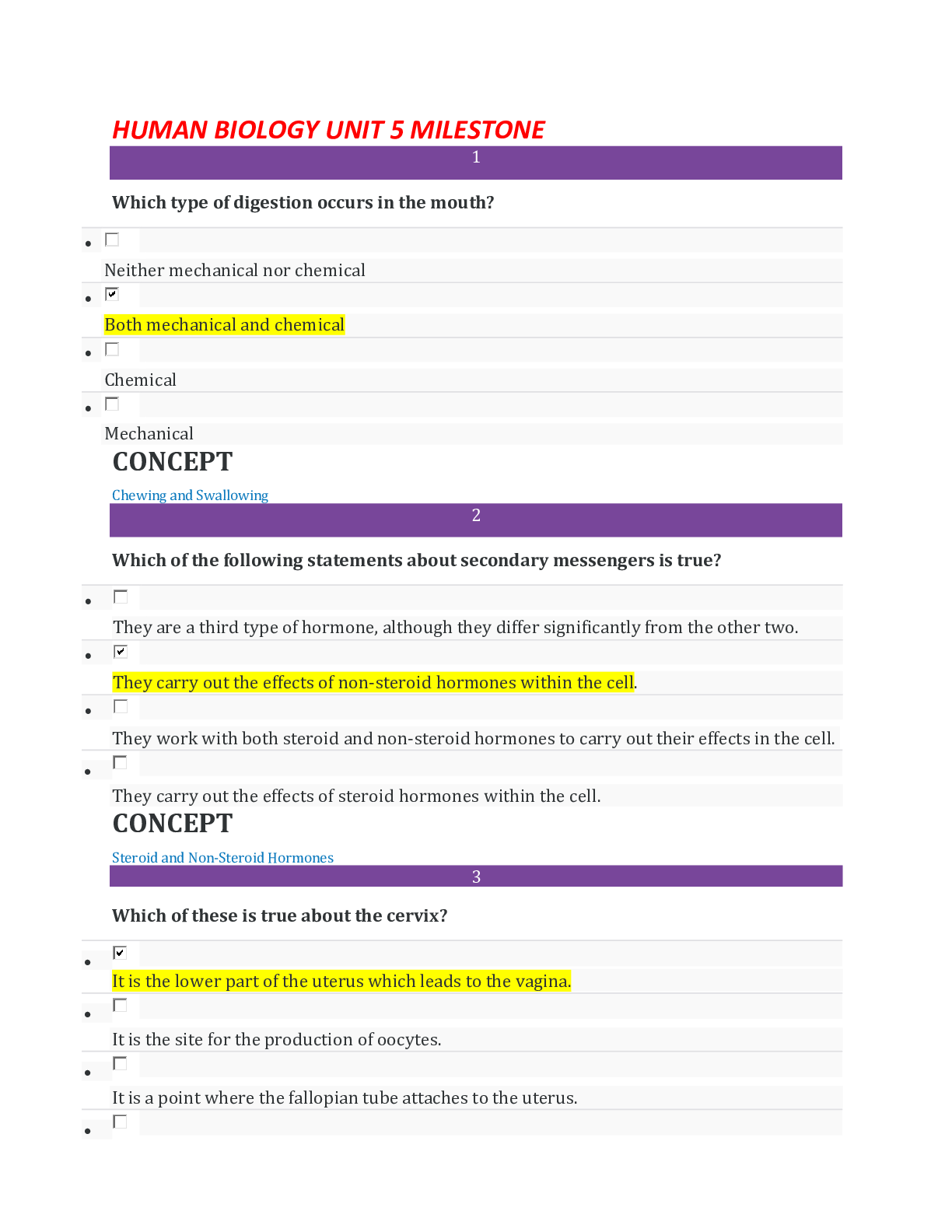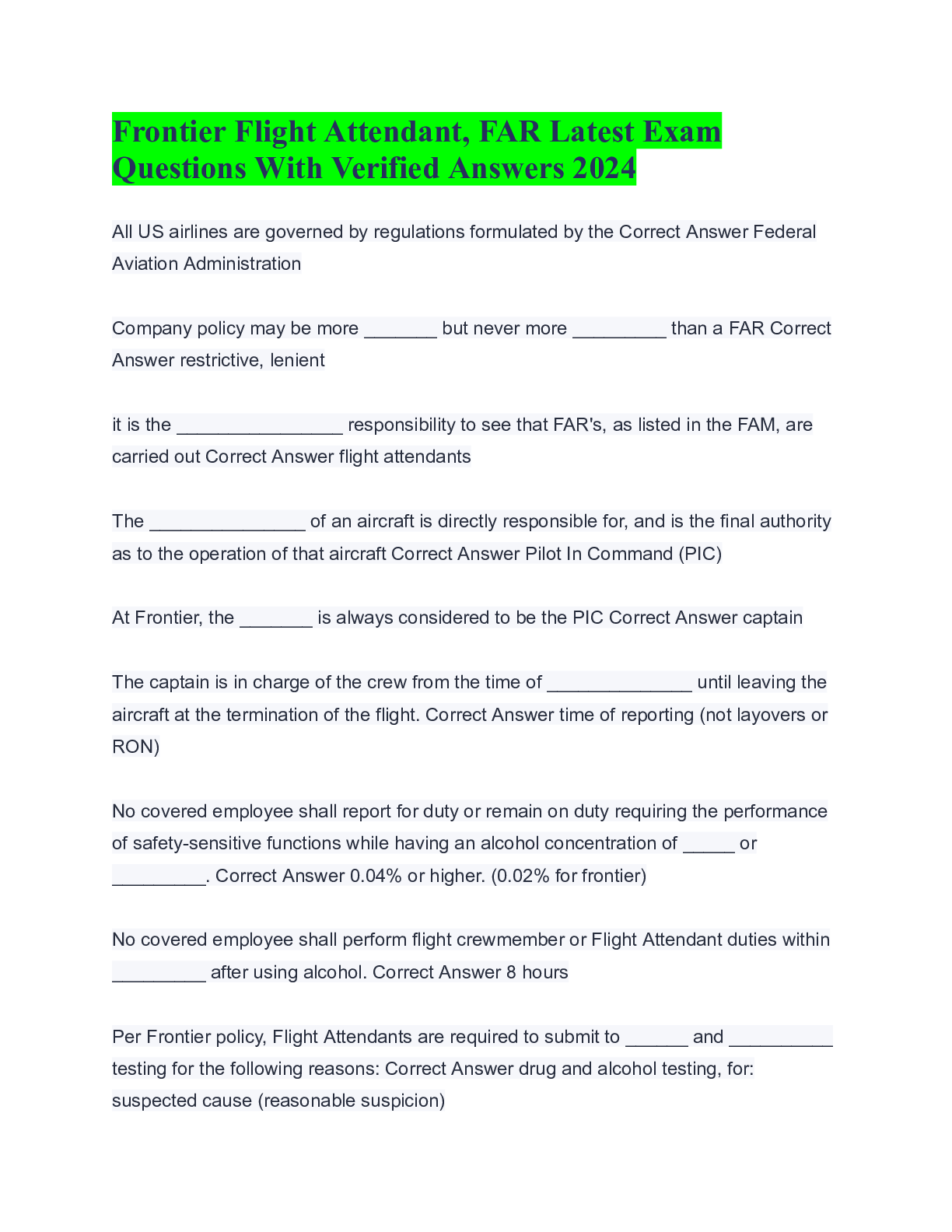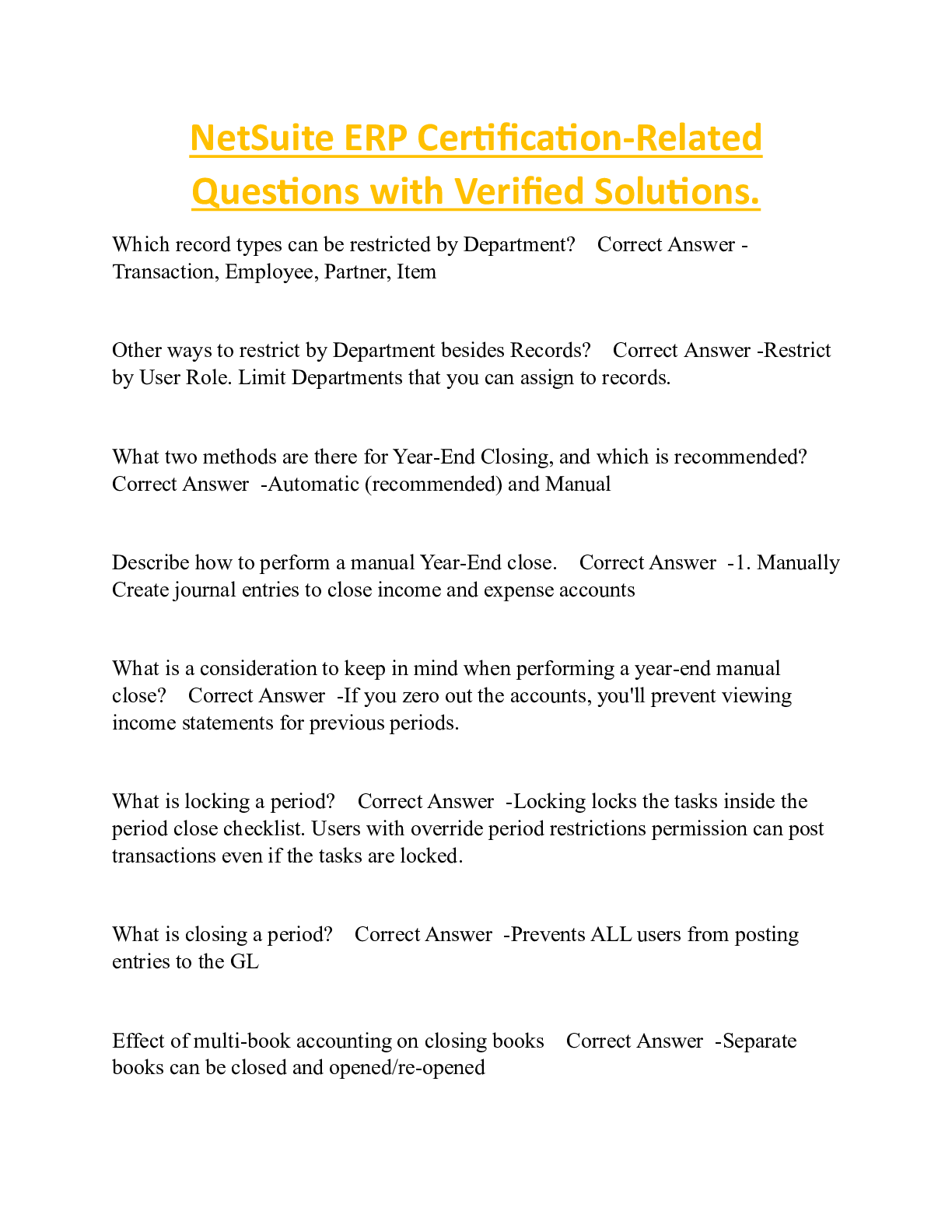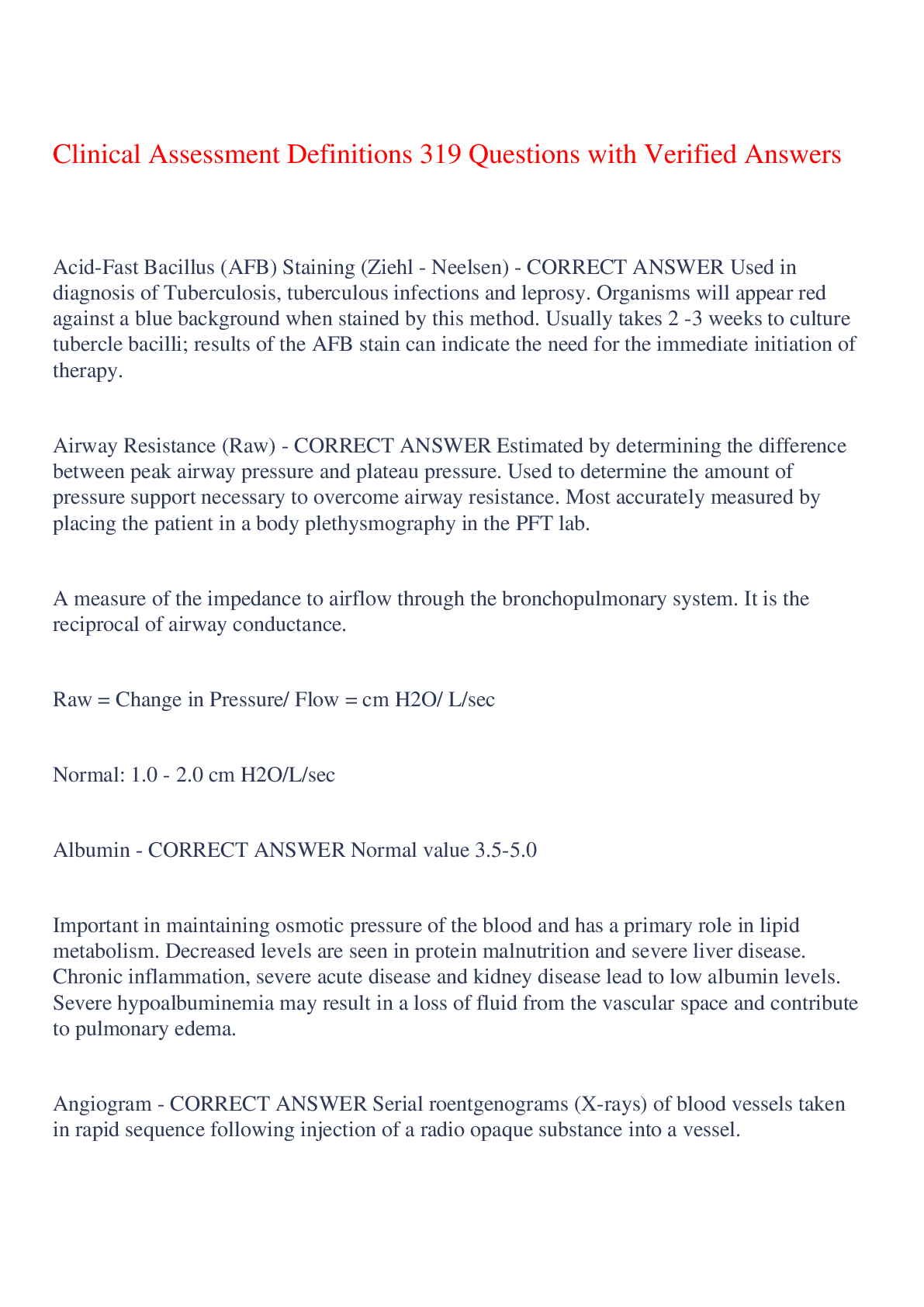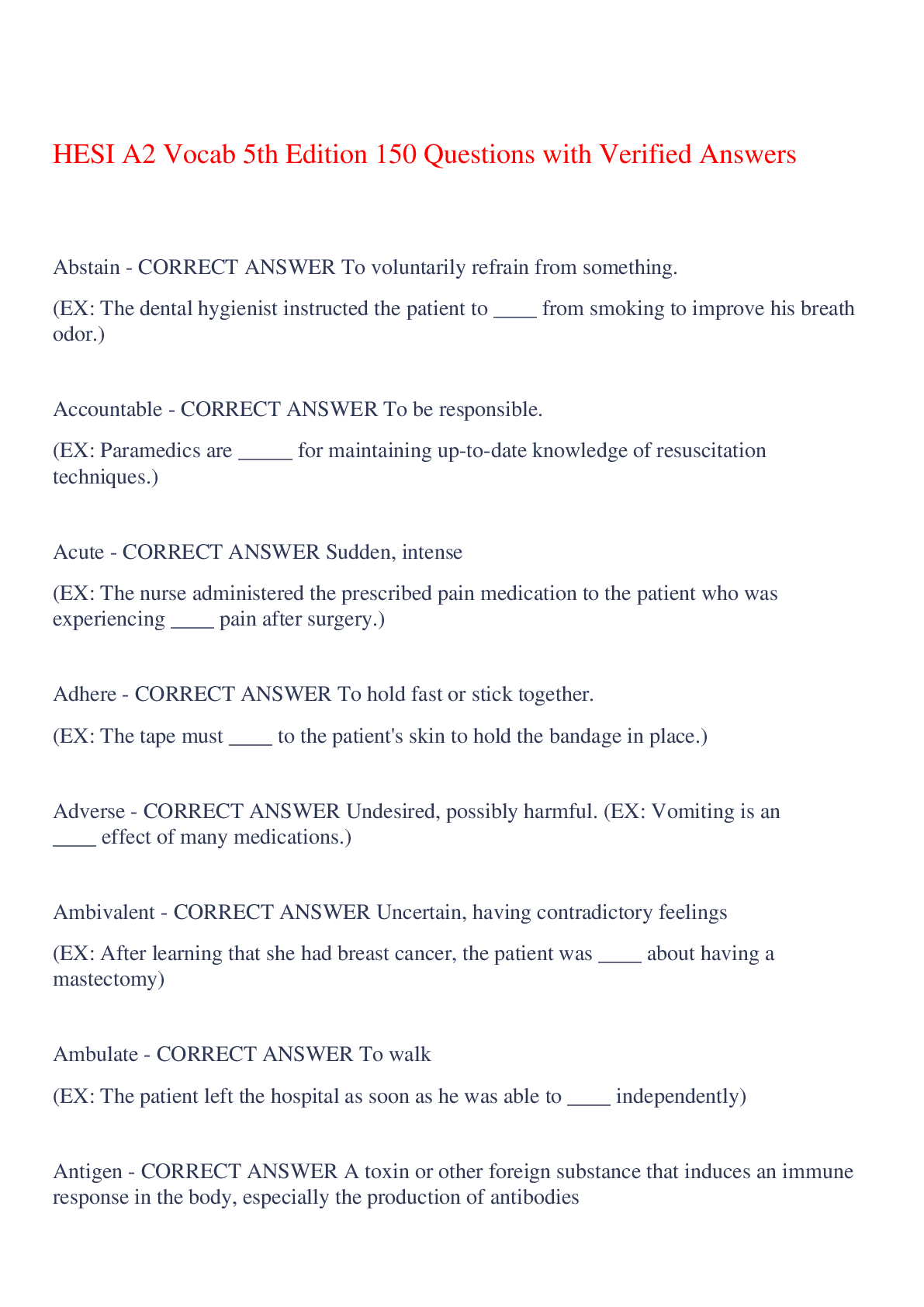*NURSING > EXAM > UWF: EDF 6225-Foundations of ABA (Exam 1) 141 Questions with Verified Answers,100% CORRECT (All)
UWF: EDF 6225-Foundations of ABA (Exam 1) 141 Questions with Verified Answers,100% CORRECT
Document Content and Description Below
UWF: EDF 6225-Foundations of ABA (Exam 1) 141 Questions with Verified Answers Although most of you are preparing for the BACB certification exam, please know that the material is based on the work ... of ________ and his science and philosophy of human behavior. There are occasions where we may spend time on items that are no longer specifically required for the exam, but we feel are required to be an excellent behavior scientist. - CORRECT ANSWER B.F. Skinner The ________ is the only standardized form of data measurement in our science. In this course, you will be charting your own behavior - specifically your daily study of ABA terminology. - CORRECT ANSWER Standard Celeration Chart (SCC) The Behavior Analyst Certification Board (BACB) is the single governing body for professionals in the field of _______. The BACB was established in 1998 to provide certification to professionals in an effort to establish minimum criteria to be a reactionary in the field. - CORRECT ANSWER Applied Behavior Analysis The standard celeration chart is the only standardized form of data ______ in our science. - CORRECT ANSWER measurement The word _______ refers to a systematic approach for seeking and organizing knowledge about the natural world. - CORRECT ANSWER systematic approach Scientific investigations can yield information regarding the three levels of understanding, which are _____ ,_______ , and _______. - CORRECT ANSWER description, prediction, control. What is the purpose for this systematic approach? - CORRECT ANSWER -To achieve a thorough understanding of the phenomena under study. -To seek to discover the real truths. --so no bias by groups or organizations --or by the scientists themselves. _______ studies produce a collection of facts about the observed events that can be quantified, classified, and examined for possible relations with other known facts. (Can also suggest hypothesis, questions, or additional research ideas.) - CORRECT ANSWER Description The highest level of scientific understanding is ________ . In this regard, we specifically manipulate one event (the independent variable) in order to produce a reliable change in another event (the dependent variable), and the change in the dependent variable is not likely due to other extraneous factors (known as confounding variables). This relationship is referred to as a _______. - CORRECT ANSWER Control; functional relationship The _________ is the event in which we observe change. - CORRECT ANSWER dependent variable What is a functional relationship? - CORRECT ANSWER It exists when a well-controlled experiment demonstrates that a specific change in one event (the dependent variable) is reliably produced by specific manipulations of another event (the independent variable), and that the change in the dependent variable was unlikely to be the result of other extraneous factors (confounding variables). The _______ is the event in which we manipulate. - CORRECT ANSWER independent variable The "behavior" we wish to change in behavior analysis is known as the _________. (2) - CORRECT ANSWER dependent variable (2) The "intervention" we employ in behavior analysis is known as the ________. (2) - CORRECT ANSWER independent variable (2) When we apply an intervention, we are manipulating the _______ . The change we see in the target behavior is known as the ________. - CORRECT ANSWER independent variable; dependent variable A _______ is demonstrated when we ________ the independent variable and see a ____ in the dependent variable and that change is not likely due to______. - CORRECT ANSWER functional relationship; manipulate; change; extraneous variables ______ is the assumption that the universe is a lawful and orderly place in which phenomena occur as a result of other events. _______ is the objective observation of the phenomena of interest. _______ is the repeating of experiments to determine the reliability and usefulness of the findings. - CORRECT ANSWER Determinism; Empiricism; Replication What is Determinism? - CORRECT ANSWER -The idea that scientists follow that the universe is a lawful and orderly place in which all phenomena occur as the result of other events. -Events do not occur at will. -Events are related in systematic ways. What is Accidentalism? - CORRECT ANSWER The idea that events occur by accident or without cause. What is Fatalism? - CORRECT ANSWER the belief that all events are predetermined and therefore inevitable. The scientific discovery of functional relations and use of these discoveries to improve things would be impossible. Can Accidentalism and Fatalism occur concurrently with Determinism? - CORRECT ANSWER NO. They are actually antithetical (opposite) to determinism. What is Empiricism? - CORRECT ANSWER The practice of object observation of the phenomena or interest. The basis on which all scientific knowledge is built from. _______ is ensuring we consider the simplest, most logical explanation of a phenomenon before more complex explanations are considered. - CORRECT ANSWER Parsimony What is parsimony? - CORRECT ANSWER all simple explanations are ruled out before more complex or abstract explanations are considered. Why is parsimony important? - CORRECT ANSWER Parsimonious interpretations help scientists assess and fit new findings within the field's existing knowledge base. A fully parsimonious interpretation consists only of those elements that are necessary and sufficient to explain the phenomenon at hand. In other words, given a choice between two competing and compelling explanations for the same phenomenon, one should shave off extraneous variables and choose the simplest explanation, the one that requires the fewest assumptions. What is an experiment? - CORRECT ANSWER A controlled comparison of some measure of the phenomena of interest (DV) under two or more different conditions in which only one factor at a time (IV) differs from one condition to another. What is replication? - CORRECT ANSWER The exact repeating of scientific experiments. Why is replication important? - CORRECT ANSWER It is the primary method with which scientist determine the reliability and usefulness of their findings and discover their mistakes. Replication is the primary reason science is self-correcting Enterprise that ultimately gets it right (not the infallibility or inherent honesty of scientists). (in ABA replication to be done with the exact same experiment, or reintroducing the same condition more than one time to see if you get the same results each time. This is essentially using someone as their own control group doing a single subject design we can get that replication using the same person over and over again) What is philosophic doubt? - CORRECT ANSWER -The Continuous questioning of the truthfulness and the validity of all scientific theory and knowledge. -Using scientific evidence before implementing a new practice and monitoring the effectiveness of the practice after its implementation. Why is philosophic doubt important? - CORRECT ANSWER The skeptical practitioner not only requires scientific evidence before implementing a new practice but also evaluates continually it's effectiveness once the practice has been implemented. Practitioners must be particularly skeptical of extraordinary claims made for the effectiveness of new theories, therapies, or treatments. You need to continuously question everything or you're missing the opportunity to expand on knowledge that's already found and your decreasing the credibility of something by not continuously researching and questioning. Behavior analysis has three major branches: behaviorism, the experimental analysis of behavior, and applied behavior analysis. _______ is the natural science approach for discovering orderly and reliable relations between behavior and various type of environmental variables of which is the function. _______ is the philosophy of the science of behavior. - CORRECT ANSWER Observable behavior; Behaviorism A working definition of science:... - CORRECT ANSWER - a systematic approach to the understanding of natural phenomena. -as evidence by description, prediction, and control. -that rely on determinism as its fundamental assumption. -empiricism as its prime directive. -experimentation as its basic strategy. - replication as its necessary requirement for believbility. -parsimony as a conservative value. - and philosophic doubt as its guiding conscience. _____ was established by Baer, Wolf, and Risley (1968) with seven guiding dimensions. (2) - CORRECT ANSWER Applied Behavior Analysis (2) Describe the development of Applied Behavior Analysis. - CORRECT ANSWER Psychology in the early 1900s was dominated with the study of states of Consciousness, images, and other mental processes. Introspection, the act of carefully observing one's own conscious thoughts and feelings, was a primary method of investigation. Who was John B. Watson? - CORRECT ANSWER Watson argued that the proper subject matter for psychology was not states of mind or mental processes but observable behavior. Further, the objective study of behavior as a natural science should consist of direct observation of the relationships between environmental stimuli (S) and the responses (R) they evoke. Watsonian behaviorism became known as stimulus-response (S-R) psychology. Although scientific evidence was insufficient to support S-R psychology as a workable explanation for most behavior, Watson was confident that his new behaviorism would lead to the prediction and control of human behavior and that it would allow practitioners to improve performance in areas such as education, business, and law. Watson (1924) made bold claims concerning human behavior (too bold). What did John B. Watson bring to the field of psychology? - CORRECT ANSWER -observable behavior (Watson argued that the proper subject matter of Psychology was not the states of mind or mental processes but the observable Behavior. There are some parts of the behavior that we see outside of the body.) -(S-R) psychology (so there's a stimulus and a response. Watson's behaviorism becomes known as the stimulus response psychology or S-R psychology) -Foundations for the study of behavior as a natural science. (Consist of direct observation of the relationships between environmental stimuli (S)(the S in psychology) and the responses (R) they evoke. He made a strong case for the study of behavior as a natural science on a par with the physical and biological sciences.) Define behaviorism. - CORRECT ANSWER It is the philosophy of the science of behavior, basic research is the province of the experimental analysis of behavior (EAB), and developing a technology for improving behavior is the concern of applied behavior analysis (ABA). _______ attempts to explain all behavior, including private events such as thinking and feeling. _______ is the philosophical position that considers behavioral events that cannot be publicly observed outside the realm of science. These two are drastically different. - CORRECT ANSWER Radical behaviorism; Mentalism Who is B.F. Skinner and why do we still learn about him today? - CORRECT ANSWER He did the radical behaviorism and he defined operant behavior. One of the founding fathers of a ABA. Skinner did a lot including when we talked about verbal Behavior, operant behavior, the history of radical behaviorism, and the development of Aba. What is Mentalism? - CORRECT ANSWER A mental or "inner" Dimension exist that is different from a behavioral dimension. What role does mentalism play in Skinners radical behaviorism? - CORRECT ANSWER So with radical behaviorism, we're saying that because of mentalism we essentially could study what happens internally with thought processes and reinforcement processes that happen entirely inside of someone. But that is more difficult because it is going to be less accessible. Meanwhile observable behavior is much easier. Describe Respondent Beahvior - CORRECT ANSWER -It is reflexive behavior -Ivan Pavlov (1927/1960) -Respondents are elicited ("brought on by") stimuli that immediately precedes them. -Antecedent stimulus and response it elicits from a functional unit called a reflex. -Involuntary response. -Occur whenever elicit stimulus is present. -S-R model (represents it) (dog drooling is respondent bx) Describe Operant behavior. - CORRECT ANSWER -Behavior is shaped through the consequences that immediately follow it. -Three-term contingency. -S-R-S model (an extra stimulus is added at the end, which is also how behavior is formed). -Behaviors that are influenced bu stimulus changes that have followed the behavior in the past. Give an example of Operant behavior. - CORRECT ANSWER if I had a dog on the nose every time it comes to me over the overtime that dog is going to come to me less and less dogs learned that after the response of coming to me to be pet but she will receive the signals of getting hit that behavior will change. behaviors are influenced by stimulus changes that have followed the behavior of the past. So what has happened to us before we learn from it and change how we interact. what is radical behaviorism (Skinner's behaviorism). it Makes three assumptions about the nature of private events. - CORRECT ANSWER -private events such as thoughts and feelings or behavior. -behavior that takes place within the skin is distinguished from other "public" behavior only by its inaccessibility. -private Behavior has no special properties and is influenced by (i.e. is a function of) the same kinds of variable as publicly accessible Behavior. define radical behaviorism - CORRECT ANSWER -makes 3 assumptions about the nature of private events. -includes and seeks to understand all human behavior. --far reaching and thouroughgoing --dramatic departure from other conceptual systems. describe 1950s FUller (1949) - CORRECT ANSWER one of the first studies to report human application of operant behavior. -participant 18 year old boy with profound intellectual disability -arm raising response was conditioned by injecting a small amount of a warm sugar milk solution into participants mouth every time he moved his right arm describe Ayllon and Michael (1959) - CORRECT ANSWER -"the psychiatric nurse as a behavior engineer" -forms of bias for branch of behavior analysis that would later be called applied Behavior Analysis Aba -describe techniques based on principles of behavior to improve the functioning of chronic psychotic or presidents with intellectual disabilities describe the 1960s - CORRECT ANSWER -researchers began to apply principles of behavior and effort to improve socially important Behavior. -techniques for measuring behavior and controlling and manipulating variables were sometimes unavailable or inappropriate. -little funding was available -no ready outlets for publishing studies -application of Behavioral principles to education is a major area of impact. --provide foundation for ---behavioral approaches to curriculum design ---instructional methods ---classroom management ---generalization and maintenance of learning (not a great time for a VA, used for bad things like conversion therapy) describe the 1960s-1970s - CORRECT ANSWER -1968 formally begining of Contemporary applied Behavior Analysis --Journal of Applied behavioral analysis (JABA) began publication. ---first journal in US to deal with applied problems and gave researchers using methodology from experimental analysis of behavior and outlet for publishing their findings. ---Flagship Journal of Aba (and remains) --"some current dimensions of Applied behavioral analysis" ( bear ,wolf ,and risley) ---founding fathers of the new discipline (Aba) ---defined the criteria for judging adequacy of research and perspective and ABA and outlined the space of work for those in the science. ---most widely cited publication in aba ---remains standard description of the discipline In the early 1900's the struggling field of psychology was based on introspection and states of _________ , relying on case studies to document work. - CORRECT ANSWER consciousness B.F. Skinner is credited with developing what Watson previously described into the actual science of behavior by conducting thousands of experiments that demonstrated orderly and reliable relationships between behavior and the ________. This work was published in the _______ (1938/1966) and should be added to every behavior analyst's library. - CORRECT ANSWER environment; JABA what are the the components of applied behavior analysis? - CORRECT ANSWER -applied -behavioral -analytic -technological -conceptually systematic -effective -capable of generalized outcomes Describe the applied component of applied behavioral analysis. - CORRECT ANSWER -investigate socially significant behaviors with immediate importance to the participants. -behaviors include --social --language --academic --daily- living --self-care --vocational --recreation and/or leisure (important to the participant is Paramount but this doesn't always happen in practice. applied also signaled Aba's commitment to affecting Improvement in behaviors that enhance and improve people's lives.) describe the behavioral component of aba. - CORRECT ANSWER -precise measurements of the actual behavior in need of improvement and documents that it was the participants behavior that changed. --the behavior in need of improvement and it is a study of behavior (not about Behavior). --the behavior must be measurable. --important to note whose Behavior has changed. why is it important to note whose Behavior has changed? - CORRECT ANSWER perhaps only the behavior of the Observer has changed, which shows "whether the study was appropriately Behavioral". perhaps the experimenter changed in an unplanned way, making it appropriate to attribute any observed change in the subject's behavior to the independent variables that were manipulated. -to see how these respondents change over time. describe the analytic component of aba. - CORRECT ANSWER demonstrates experimental control over the occurrence and non-occurrence of the behavior (a functional relation is demonstrated). what does experimental control look like? - CORRECT ANSWER what does experimental control look like?maybe changing the antecedent before math class could change the behavior rather than changing the consequence or if she is normally removed from class when she can't run then we would stop the consequences when she Tantrums. probably best to look at the environment first before looking at consequences because of sensory overload could be the antecedent for responses or behaviors that are considered unpleasant or aggressive. Maybe shift environment for someone with sensory overload. describe the technological component of aba. - CORRECT ANSWER -written description of all procedures in the study is sufficiently complete and detailed to enable others to replicate it written description of all procedures in the study is sufficiently complete and detailed to enable others to replicate it. -all operative procedures are identified and described in detail and clearly. what does it mean to replicate a study? - CORRECT ANSWER done the exact same way each time. describe the conceptually systematic component of aba. - CORRECT ANSWER -Behavior change interventions are derived from basic principles of behavior. -better enable research consumers to derive other similar procedures from the same principles. -assist integrating discipline into a system instead of a collection of tricks. (the interventions that we use are derived from these basic principles of behavior. Studied multiple times through multiple people.) describe the affective component of Aba. - CORRECT ANSWER -improve Behavior sufficiently to produce practical results for the participant. -improvements in Behavior must reach clinical or social significance. -extent to which changes in the Target Behavior results in noticeable changes. (so was it easy to observe that the target Behavior has actually changed. Did it improve and did it improve in a way that produce practical results for the participant) describe the generality component of aba. - CORRECT ANSWER -produces Behavior changes that last over time -appear in other environments (other than the one in which intervention was implemented) -or spread to other behaviors (those not directly treated by the intervention) describe aba - CORRECT ANSWER the science in which tactics derived from principles of behavior are applied systematically to improve socially significant behaviors and experimentation is used to identify the variables responsible for Behavior change The _____dimension of ABA was summarized by Baer et al. (1968): "applied research is constrained to examining behaviors which are _____ important, rather than convenient for study" (p. 92). These are other wise known as _______. - CORRECT ANSWER current; socially; socially signifigant ______ is the dimension in which we are certain that we not only changed behavior, but we know whose behavior changed. - CORRECT ANSWER behavioral ______ defines how we arrive to our decision as to whether or not behavior change occurred as we predicted. - CORRECT ANSWER analytic ________ means that we fully disclose all of the procedures we followed in order to measure behavior before and during intervention, as well as to how the intervention was applied. - CORRECT ANSWER technological ______ procedures mean that we rely on behavioral procedures derived from the research, not just random attempts to change behavior. - CORRECT ANSWER conceptually systematic _______ is when the applied behavior we selected was objectively measured and it demonstrated a reliable change. - CORRECT ANSWER effective ______ is the golden standard of our procedures. It simply means that the intervention not only changed the behavior in a particular setting, with a particular person, but that in generalized to other environments and it maintained long after we exited the picture. - CORRECT ANSWER generality When a stimulus is added and future frequencies of behavior maintain or increase, it is known as ______ reinforcement. - CORRECT ANSWER positive _______ _________ is when stimulus is added and future occurrences of behavior decreases. - CORRECT ANSWER positive punishment When a stimulus is removed and future frequencies of behavior maintain or increase, it is know as ________. - CORRECT ANSWER negative reinforcement. When a _______ is added and future frequencies of behavior maintain or increase, it is known as positive reinforcement - CORRECT ANSWER stimulus ______punishment is when stimulus is added and future occurrences of behavior decreases. (2) - CORRECT ANSWER positive (2) When a stimulus is _______ and future frequencies of behavior maintain or increase, it is know as negative reinforcement. - CORRECT ANSWER removed Positive ______ is when stimulus is added and future occurrences of behavior decreases. - CORRECT ANSWER punishment When a stimulus is added and future frequencies of behavior maintain or increase, it is known as positive _______. - CORRECT ANSWER reinforcement ______ reinforcement is when a stimulus is removed and future frequencies of behavior maintain or increase. - CORRECT ANSWER negative When a stimulus is added and frequencies _____ of behavior maintain or increase, it is known as positive reinforcement. - CORRECT ANSWER future Positive ______ is when a stimulus is ______ and future frequency of behavior increases or stays the same. - CORRECT ANSWER positive; added When a stimulus is ____ and future frequencies of behavior maintain or increase, it is known as positive _____ - CORRECT ANSWER added. reinforcement ______punishment is when a stimulus is added and future occurrences of behavior______ - CORRECT ANSWER positive; decrease _______reinforcement is when a stimulus is removed and future frequencies of behavior - CORRECT ANSWER negative Reinforcement theory is a ________. That means all of its components are defined by their function (how they work) rather than by their ________ (how they look). - CORRECT ANSWER functional theory; structure Positive reinforcement is a functional relation defined by a two-term contingency: A response is followed immediately by the ________ of a stimulus, and, as a result, similar responses occur more ________ in the future. - CORRECT ANSWER presentation; frequently The stimulus change responsible for the increase in responding is called a _______. A delay (as long as even one second) can _______ the intended effects of a stimulus because it allows for another, unintended stimulus to happen prior to the intended stimulus. - CORRECT ANSWER reinforcement; change In addition to increasing the future frequency of the behavior it follows (consequence stimuli), ________ changes the function of antecedent stimuli. This antecedent stimulus may evoke behavior because it is correlated with the availability of reinforcement and is known as the _______ . - CORRECT ANSWER reinforcement; discriminative stimulus The discriminative stimulus only signals the _______ of a reinforcer. It does not change the effectiveness of a reinforcer. - CORRECT ANSWER occurance A ___________ increases or decreases the current effectiveness of a reinforcer. A motivating operation does not signal the ______ of a reinforcer. - CORRECT ANSWER motivating operation; occurrance The refrigerator may typically signal the availability of food and food could be considered a _________ if you are hungry. - CORRECT ANSWER reinforcer Your hunger is not contingent on the availability of the refrigerator - it can happen anywhere. Your hunger is considered a ______________ . - CORRECT ANSWER motivating operation Your refrigerator may be available when you are not hungry. It is always there. Your refrigerator is simply a signal for the availability of reinforcement, otherwise known as the ________. - CORRECT ANSWER discriminative stimuli _____________ are stimuli that function as reinforcement without requiring a learning history. These stimuli are the product of phylogenic development, meaning that all members of a species are susceptible to the same properties of stimuli. - CORRECT ANSWER unconditioned reinforcers ___________________ are previously neutral stimuli that function as reinforcers as a result of prior pairing with one or more other reinforcers. - CORRECT ANSWER conditioned reinforcers A _________________is a conditioned reinforcer that has a result of having been paired with many unconditioned and conditioned reinforcers does not depend on a current EO for any particular form of reinforcement for its effectiveness. - CORRECT ANSWER generalized conditioned reinforcer As Skinner (1989) pointed out, the powerful reinforcer "does not need to be ______ for instructional purposes; it is unrelated to any particular kind of behavior and hence always available. We call it success." (p.91). - CORRECT ANSWER contrived An _____________ is one in which responding terminates an ongoing aversive stimulus. - CORRECT ANSWER escape contingency An ___________ is one in which responding delays or prevents the presentation of an aversive stimulus. - CORRECT ANSWER avoidance contingency In _______, responding in the presence of a signal prevents stimulus presentation; in _______ avoidance, responding at any time prevents stimulus presentation. - CORRECT ANSWER discriminated avoidance; free-operant Removal and reduction of ongoing stimulation typically produce behavior that is called "________ "; whereas, postponement and prevention of stimulus presentation produce behavior that is called "________ ". - CORRECT ANSWER escape; avoidance Escape _________ as an intervention may actually backfire and shape more dangerous behavior - CORRECT ANSWER maintained behavior According to Ruddle et al. (as cited in Iwata, 1987), positively reinforced behavior may compete with, but will not suppress _______ or _______ responding that is reinforced concurrently. - CORRECT ANSWER escape; avoidance According to Iwata, _______ might be considered more intrusive than punishment because, with negative reinforcement, presentation of the aversive stimulus is contingent on the absence, rather than the occurrence, of behavior. - CORRECT ANSWER negative reinforcement Punishment has occurred when a stimulus change immediately follows a response and ______ the future frequency of that type of behavior in similar conditions. - CORRECT ANSWER decreases Punishment is defined neither by the actions of the person delivering the consequences nor by the nature of those consequences. A decrease in the future frequency of occurrence of the behavior must be observed before consequent-based intervention qualifies as _________. - CORRECT ANSWER punishment ________has occurred when the frequency of responding has been decreased by the removal of a stimulus immediately following a behavior. - CORRECT ANSWER negative punishment ________ has occurred when the frequency of responding has been decreased by the presentation of a stimulus immediately following a behavior. - CORRECT ANSWER positive punishment Because aversive events are associated with positive punishment and with negative reinforcement, the term ______ control is often used to describe interventions involving either or both of these contingencies - CORRECT ANSWER aversive A _________ is a stimulus that has acquired its punishing capabilities by being paired with unconditioned or conditioned punishers. - CORRECT ANSWER conditioned punisher A _____ is a stimulus change that immediately follows the occurrence of a behavior and reduces the future frequency of that type of behavior. - CORRECT ANSWER punishment Dr. Murry Sidman summarized many times that we consider virtue to be its own _______ . He also indicated that it is a myth to believe that punishment does not teach anything because it effectively teaches avoidance and _______ (Sidman, 1993). - CORRECT ANSWER punishment; escape Punishment must be paired with _____ . The power of punishment techniques is that they can rapidly ______ an individual's rate of problem behaviors. But merely suppressing unacceptable behaviors is not enough: the individual should also be taught appropriate and functional behaviors. - CORRECT ANSWER reinforcement; decrease Negative punishment has occurred when the frequency of responding has been decreased by the _______ of a stimulus immediately following a behavior. - CORRECT ANSWER removal Because aversive events are associated ________ with and with ________ , the term aversive control is often used to describe interventions involving either or both of these contingencies. - CORRECT ANSWER positive punishment; negative reinforcement _________ , which is when a person or device blocks a response to prevent it from completing, would be considered _______ (based on evidence from behavior decreasing). - CORRECT ANSWER response blocking; (i answered "positive" and it said correct but i think it is actually punishment; "punishment") ________ is defined as withdrawal of the opportunity to earn positive reinforcement or the loss of access to positive reinforcers for a specified time. This would be considered _______ punishment (based on evidence from behavior decreasing). - CORRECT ANSWER time out "from positive reinforcement"; negative _________ is when, contingent upon a problem behavior, the learner is required to engage in effortful behavior that is directly or logically related to the problem. This would be considered _______ punishment (based on evidence from behavior decreasing). - CORRECT ANSWER overcorrention; positive ______ is a form of punishment in which the loss of specific amount of reinforcement occurs, contingent on the performance of an inappropriate behavior and results in the decreased probability of the future occurrence of the behavior. This would be considered _____ punishment (based on evidence from behavior decreasing). - CORRECT ANSWER time-out negative _______ is when the learner must repair the damage caused by the problem behavior and then bring the environment back to a condition that is notably improved than before the behavior occurred. - CORRECT ANSWER restitutional overcorrection A direct fine is an example of a _______ - CORRECT ANSWER (i put "negative punishment" but i think it is actually "response cost" Time out will typically be ineffective if "time in" is not _____ - CORRECT ANSWER reinforcing A conditioned punisher is a stimulus that has acquired its punishing capabilities by being paired with _______. - CORRECT ANSWER unconditioned punishers A punisher is a stimulus change that immediately follows the occurrence of a behavior and ______ the future frequency of that type of behavior - CORRECT ANSWER decreases ______ can result from abrupt increase in ration requirements when moving from denser to thinner reinforcement schedules - CORRECT ANSWER role strain If the contingency between responses and reinforcement depends on time, the schedule is called an ______ - CORRECT ANSWER interval If the contingency between responses and reinforcement depends on the number of responses, the schedule is called a ______ - CORRECT ANSWER ratio A _____ ratio schedule requires a specified number of responses before a response produces reinforcement. - CORRECT ANSWER fixed A variable ______ schedule requires a variable number of responses before a response produces reinforcement. - CORRECT ANSWER ratio A fixed ______ schedule provides reinforcement for the first response following the elapse of a specific, constant duration of time since the last reinforced response. - CORRECT ANSWER interval A ______ interval schedule provides reinforcement for the first response following the elapse of variable duration of time since the last reinforced response. - CORRECT ANSWER variable When a ______ is added to an interval schedule, reinforcement remains available for a finite time following the elapse of the FI or VI interval. - CORRECT ANSWER limited hold _______ are where reinforcement occurs when (a) two or more contingencies of reinforcement (b) operate independently and simultaneously (c) for two or more behaviors. - CORRECT ANSWER concurrent schedule ______ are where reinforcement occurs in an alternating, usually random sequence and can be identified by the discriminative stimulus. - CORRECT ANSWER multiple schedules A _____ requires a variable number of responses before a response produces reinforcement. - CORRECT ANSWER variable ratio ______ are much like the multiple schedules in that it relies on discriminative a stimulus; however, the order is not random - it is always the same. - CORRECT ANSWER chained schedules A ______ provides reinforcement for the first response following the elapse of a specific, constant duration of time since the last reinforced response. - CORRECT ANSWER fixed interval Herrnstein conceptualized the ______ by discovering a near perfect correlation between reinforcement and behavior. - CORRECT ANSWER matching law A ______ provides reinforcement for the first response following the elapse of variable duration of time since the last reinforced response. - CORRECT ANSWER variable interval "...make it less effortful for the learner to obtain high rates of immediately available, high-quality rewards for the desired behavior, relative to those associated with undesirable behavior" This describes the four dimensions of a reinforcer, which include _____, ______, ______, and ____. - CORRECT ANSWER contingency, immediacy, size, and deprivation [Show More]
Last updated: 5 months ago
Preview 1 out of 20 pages
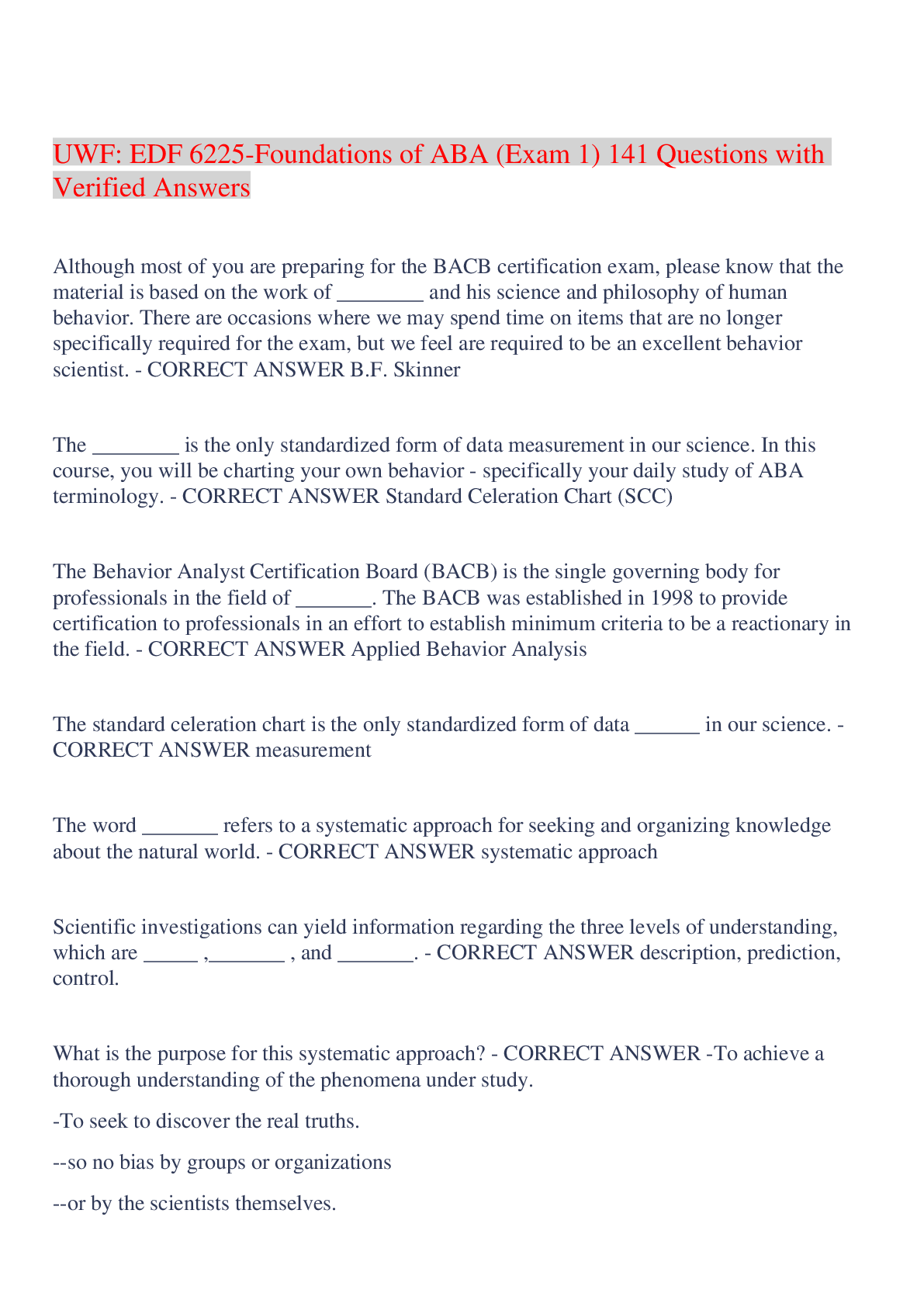
Reviews( 0 )
Document information
Connected school, study & course
About the document
Uploaded On
Dec 15, 2023
Number of pages
20
Written in
Additional information
This document has been written for:
Uploaded
Dec 15, 2023
Downloads
0
Views
55




